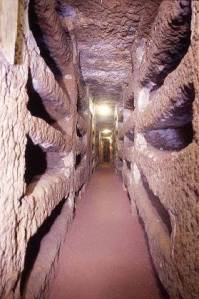The Catacombs of Rome are ancient catacombs, or underground burial places under or near Rome, of which there are at least forty, some discovered only in recent decades. Though most famous for Christian burials, either in separate catacombs or mixed together. They began in the 2nd century, much as a response to overcrowding and shortage of land. That catacombs came about to help persecuted Christians to bury their dead secretly, but this myth has been debunked: among other reasons, catacombs always were along major highways (which would have meant they couldn’t be kept secret for long), pagans also used catacombs although their religion was legal, and most catacomb building took place after Christianity’s legalization. The soft volcanic tufo rock under Rome is highly suitable for tunnelling, as it is softer when first exposed to air, hardening afterwards. Many have kilometres of tunnels, in up to four stories (or layers).
The Christian catacombs are extremely important for the art history of early Christian art, as they contain the great majority of examples from before about 400 AD, in fresco and sculpture.
Roman catacombs are made up of underground passages (ambulacra), out of whose walls graves (loculi) were dug. These loculi, generally laid out vertically (pilae), could contain one or more bodies. Another type of burial, typical of Roman catacombs, was the arcosolium, consisting of a curved niche, enclosed under a carved horizontal marble slab. cubicula (burial room containing loculi all for one family) andcryptae (chapels decorated with frescoes) are also commonly found in catacomb passages. When space began to run out, other graves were also dug in the floor of the corridors – these graves are called formae.
The most important catacombs in Rome are:
- Catacombs of Marcellinus and Peter
- Catacombs of Domitilla
- Catacombs of Commodilla
- Catacombs of Generosa
- Catacombs of Praetextatus
- Catacombs of Priscilla
- Catacombs of San Callisto
- Catacombs of San Lorenzo
- Catacombs of San Pancrazio
- Catacombs of San Sebastiano
- Catacombs of Sant’Agnese
- Catacombs of Via Anapo


